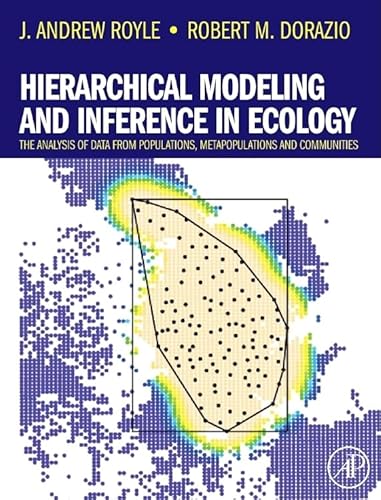Hierarchical Modeling Inference Ecology by Royle Andrew (12 results)
Search filters
Product Type
- All Product Types
- Books (12)
- Magazines & Periodicals (No further results match this refinement)
- Comics (No further results match this refinement)
- Sheet Music (No further results match this refinement)
- Art, Prints & Posters (No further results match this refinement)
- Photographs (No further results match this refinement)
- Maps (No further results match this refinement)
- Manuscripts & Paper Collectibles (No further results match this refinement)
Condition Learn more
- New (10)
- As New, Fine or Near Fine (No further results match this refinement)
- Very Good or Good (2)
- Fair or Poor (No further results match this refinement)
- As Described (No further results match this refinement)
Binding
- All Bindings
- Hardcover (12)
- Softcover (No further results match this refinement)
Collectible Attributes
- First Edition (No further results match this refinement)
- Signed (No further results match this refinement)
- Dust Jacket (No further results match this refinement)
- Seller-Supplied Images (4)
- Not Print on Demand (9)
Language (1)
Free Shipping
Seller Location
Seller Rating
-
Condition: good. Fast Free Shipping â" Good condition book with a firm cover and clean, readable pages. Shows normal use, including some light wear or limited notes highlighting, yet remains a dependable copy overall. Supplemental items like CDs or access codes may not be included.
-
Hierarchical Modeling and Inference in Ecology: The Analysis of Data from Populations, Metapopulations and Communities
Seller: Bay State Book Company, North Smithfield, RI, U.S.A.
Condition: very_good.
-
Hierarchical Modeling and Inference in Ecology: The Analysis of Data from Populations, Metapopulations and Communities
Published by Academic Press 2008-10-15, 2008
ISBN 10: 0123740975 ISBN 13: 9780123740977
Language: English
Seller: Chiron Media, Wallingford, United Kingdom
£ 53.80
£ 15.49 shipping
Ships from United Kingdom to U.S.A.Quantity: Over 20 available
Add to basketHardcover. Condition: New.
-
Condition: New. pp. 464.
-
Hardcover. Condition: Brand New. 1st edition. 444 pages. 9.25x7.75x1.25 inches. In Stock.
-
Condition: New. pp. 464.
-
Hierarchical Modeling and Inference in Ecology: The Analysis of Data from Populations, Metapopulations and Communities
Published by Elsevier Science Publishing Co Inc, 2008
ISBN 10: 0123740975 ISBN 13: 9780123740977
Language: English
Seller: THE SAINT BOOKSTORE, Southport, United Kingdom
£ 66.66
£ 20.77 shipping
Ships from United Kingdom to U.S.A.Quantity: Over 20 available
Add to basketHardback. Condition: New. New copy - Usually dispatched within 4 working days. 1002.
-
Condition: New. pp. 464.
-
Condition: new.
-
Condition: new. Questo è un articolo print on demand.
-
Hierarchical Modeling and Inference in Ecology
Published by Elsevier Science Jul 2008, 2008
ISBN 10: 0123740975 ISBN 13: 9780123740977
Language: English
Seller: BuchWeltWeit Ludwig Meier e.K., Bergisch Gladbach, Germany
Buch. Condition: Neu. This item is printed on demand - it takes 3-4 days longer - Neuware -A guide to data collection, modeling and inference strategies for biological survey data using Bayesian and classical statistical methods.This book describes a general and flexible framework for modeling and inference in ecological systems based on hierarchical models, with a strict focus on the use of probability models and parametric inference. Hierarchical models represent a paradigm shift in the application of statistics to ecological inference problems because they combine explicit models of ecological system structure or dynamics with models of how ecological systems are observed. The principles of hierarchical modeling are developed and applied to problems in population, metapopulation, community, and metacommunity systems. The book provides the first synthetic treatment of many recent methodological advances in ecological modeling and unifies disparate methods and procedures.The authors apply principles of hierarchical modeling to ecological problems, including \* occurrence or occupancy models for estimating species distribution\* abundance models based on many sampling protocols, including distance sampling\* capture-recapture models with individual effects\* spatial capture-recapture models based on camera trapping and related methods\* population and metapopulation dynamic models\* models of biodiversity, community structure and dynamics \* Wide variety of examples involving many taxa (birds, amphibians, mammals, insects, plants)\* Development of classical, likelihood-based procedures for inference, as well asBayesian methods of analysis\* Detailed explanations describing the implementation of hierarchical models using freely available software such as R and WinBUGS\* Computing support in technical appendices in an online companion web site 464 pp. Englisch.
-
Buch. Condition: Neu. nach der Bestellung gedruckt Neuware - Printed after ordering - A guide to data collection, modeling and inference strategies for biological survey data using Bayesian and classical statistical methods.This book describes a general and flexible framework for modeling and inference in ecological systems based on hierarchical models, with a strict focus on the use of probability models and parametric inference. Hierarchical models represent a paradigm shift in the application of statistics to ecological inference problems because they combine explicit models of ecological system structure or dynamics with models of how ecological systems are observed. The principles of hierarchical modeling are developed and applied to problems in population, metapopulation, community, and metacommunity systems. The book provides the first synthetic treatment of many recent methodological advances in ecological modeling and unifies disparate methods and procedures.The authors apply principles of hierarchical modeling to ecological problems, including \* occurrence or occupancy models for estimating species distribution\* abundance models based on many sampling protocols, including distance sampling\* capture-recapture models with individual effects\* spatial capture-recapture models based on camera trapping and related methods\* population and metapopulation dynamic models\* models of biodiversity, community structure and dynamics.






